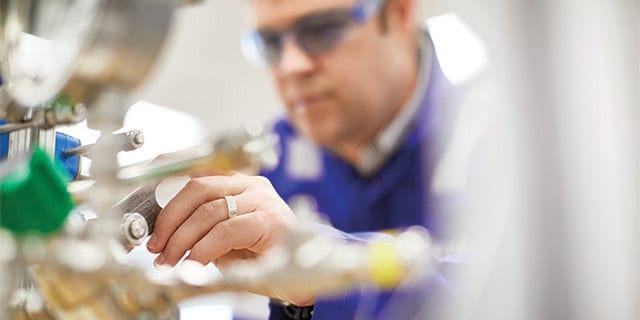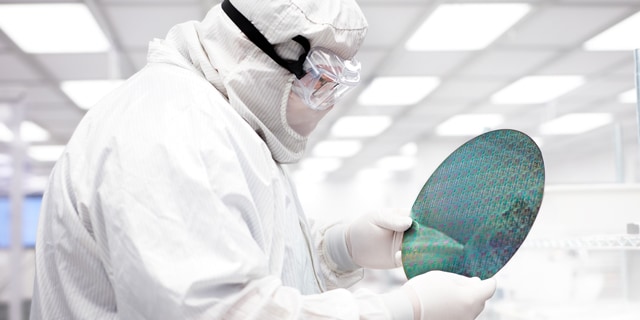Thermal Controls to Optimize Semiconductor Wafer Manufacturing

How to Optimize Semiconductor Wafer Manufacturing Yield With Proper Thermal Control
Brian Rudary, Applications Solutions Engineering Lead, Swagelok, and Doug Nordstrom, Product Manager, Swagelok
Semiconductor wafer manufacturing grows more challenging by the day. As global demand for chips skyrockets, fabs, OEMs, and all parts of the value chain continue to drive new process efficiencies and leverage new technologies to maximize yield.
One generally effective strategy for maximizing yield is maintaining ultralow temperature stability in the deposition chamber for more efficient semiconductor wafer fabrication production. But because desired temperatures now reach as low as -40 C, suboptimal performance throughout your thermal loop—the ecosystem of chillers, pumps, heat exchanges, and the components that link them—may be unacceptable in today’s fab environments.
So, how can you ensure your thermal loop is up to the task? Let’s look at three critical areas that can help you optimize thermal management in your facility, better enabling you to maximize semiconductor wafer manufacturing yield.

The thermal loop is made up of:
- Chillers, which cool the fluid that circulates through the equipment
- Heat exchangers, which deliver heated media to the space around the process chamber
- Insulated hose assemblies and weldments, pumps, and valves, which help distribute temperature-controlled fluid throughout the entire cycle
- Monitoring and control systems, which adjust the flow rates and temperature
- Filtration and purification systems, which prevent contamination and remove impurities
Optimized Component Selection
To meet the needs of today’s semiconductor wafer production processes, high-performance components that connect the critical systems of your thermal loop are vital. All components—including hoses, valves, fittings, filters, and more—should be properly rated to handle today’s pressures, flow rates, and extreme temperatures.
Consider your chiller hoses as an example. A hose must be properly insulated in order to efficiently maintain desired temperatures and to prevent condensation, a critical failure mode in tightly controlled production environments. If a chiller hose’s surface temperature is below the ambient dew point, condensation can form on the hose’s exterior. The resulting cost of downtime can be crippling.
But delivering desirable thermal performance is about more than specifying extra insulation. Instead, specifying the right level of insulation can help optimize costs while delivering reliable performance. Consider that hoses connecting components of the thermal loop may run anywhere from 30 to 50 feet long and can represent a significant cost to the manufacturer due to their critical nature. Where insufficient insulation can lead to condensation and thus hose failure, excessive insulation can further balloon the price while providing little or no benefit to the OEM or fab.
Elsewhere, other critical thermal loop components should be capable of meeting increasingly high demands. A common valve or tube fitting might not be sufficient for ultralow temperatures. Instead, components that have been developed specifically for the needs of semiconductor production environments are critical. For these reasons, working with a provider that can assist in identifying and recommending optimal components based on your specific application parameters can help OEMs and fabs meet today’s production demands.
Proper Installation Techniques and Performance Testing
While product selection is critical, effective thermal management is also dependent on proper installation and implementation. These processes are key to achieve desired process consistency, repeatability, cleanliness, and a moisture-free operating environment.
It starts with the basics. Achieving leak-tight systems is dependent on following the fundamentals of sound tube fitting and valve installation. Improper installation is one of the most common reasons why critical fluid systems fail—not just in semiconductor environments, but across industries. Profit loss, decreased production efficiency, and even safety issues are all potential outcomes of poor installation.
Elsewhere, strategic chiller line routing is another important tool to prevent condensation. When cold chiller hoses are routed too close to each other, the surface temperature of the hoses can fall below the dew point, causing condensation to form. The smaller the distance between the hoses, the closer the air temperature between the hoses will be to the media temperature in the hose. A general recommendation is to keep wrapped insulated hoses at least 12 in. (31 cm) apart. If the application requires closer spacing, additional layers of insulation may be required.
Stagnant air can also affect the surface temperature of cooling lines. As airflow increases, surface temperatures can trend more toward the ambient environment temperature. Consider a hose that is routed through a confined area, such as a subfloor. In the case of cold media flowing through the hose, this could cause condensation to form on the outside of the hose, which may drip onto sensitive equipment.
Finally, while a hose’s minimum bend radius does not change when it is insulated, bending the hose may affect the insulation properties. To minimize these effects, it is generally recommended to make softer bends with a larger bend radius. If this is not possible, consider supplementing it with additional layers of insulation.
Investing in Relationships
Because semiconductor tool OEMs and production fabs have numerous other competing priorities, maintaining effective thermal management can be done more easily by working with a consultive provider with experience in these increasingly critical systems.
A knowledgeable partner can not only help you select and specify the right components and connections but can also help reduce capital expenses and operating expenditures via streamlined processes. A partner can also offer calculation tools to help you determine a right-sized insulation based on your operational parameters. This is especially important considering that the margin for error is ever-shrinking in the fast-paced semiconductor space.
The benefits of working with a supplier that can offer these tools and expertise can be significant, including:
Reduced downtime via condensation prevention
Increased semiconductor chip yields via minimized thermal variation and efficient media transfer
Increased efficiency and reduced energy costs via improved chiller performance
Maintaining optimal functionality of the thermal loop is essential to consistent, maximized chip yield in semiconductor wafer manufacturing settings. If you’re interested in diving deeper into thermal loop management or other ways to optimize semiconductor wafer manufacturing operations through a variety of engineering solutions, our team is available for further consultation. In the meantime, you can explore Swagelok Reference Point for additional resources to help you optimize wafer production processes and other critical aspects of the semiconductor industry.
Related Articles

Optimize These Applications for More Profitable Semiconductor Fabs
As semiconductor fab construction booms around the world, manufacturers should consider how optimizing critical industrial fluid system applications can contribute to more efficient and profitable operations.

The Benefits of On-Site Field Engineering Support
Learn how specialized engineering assistance for chip manufacturers in the semiconductor industry can help improve operational efficiency.

Vacuum Face Seal Fittings Explained
Learn why vacuum face seal fittings represent an ideal solution for uncompromising ultrahigh-purity semiconductor fluid system applications.

